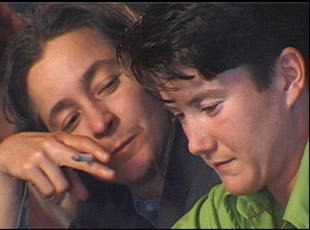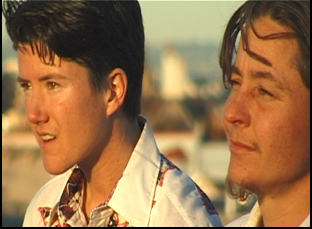“What’s an artesian?” asks Valentine (Harry Dodge) innocently enough in “By Hook or By Crook,” his curiosity piqued when his new friend Shy (Silas Howard) describes his father that way. He was a ballroom dancer, but that alone wouldn’t qualify for such a lofty title as you see the twinkle he inspires in Shy’s eyes as he speaks about him, capable of just about anything, leading him to improvise a definition on the spot in the same creative spirit that might make his father proud, “You live in the middle of nowhere and make plaques out of pine cones and macaroni.”
It surely felt like that more than a few times as Dodge and Howard embarked on their scrappy feature directorial debut, which instantly became a cinematic landmark upon its premiere at Sundance in 2002 as a rare film to boast transgender talent both in front of and behind the camera. In the years since, both Dodge and Howard have established themselves as forces to be reckoned with, with Dodge very much becoming an “artesian,” working in a variety of disciplines from literary nonfiction to experimental shorts, and Howard continuing to blaze a trail in film and television, as a producing director on “Dickinson” and returning to features in 2018 with “A Kid Like Jake,” but it was evident from “By Hook or By Crook” that they clearly were onto something from the start, able to convey the irresistible energy that one may have felt in Red Dora’s Bearded Lady Coffeehouse in San Francisco’s Mission District that the two ran along with other friends in the community into a frenetic tale of two drifters who find a home when striking up a friendship with one another.
When there were members of the burgeoning tech industry in the area that could afford to take a chance on making a film, Dodge, Howard and their co-conspirator Steak House likely said “By Hook or By Crook” in pitching it together as much as it became a mantra for themselves, getting a sense of scale on a shoestring budget as Shy and Valentine hit the road, bonding over a profound sense of loss after Shy is a year removed from losing his father and Valentine is in search of his biological mother, yearning for a sense of belonging within their own family tree that would seem to reflect their place in society at large. Pulling in Joan Jett for a cameo becomes an apropos piece of panache for the lively dramedy where Shy and Valentine fashion themselves as outlaws in the vein of the movies they grew up on, but Dodge and Howard show a rebellious streak when afforded the opportunity to make their own, building on the wave of lo-fi ‘90s indie dramas that embraced a raw aesthetic and a early digital video-era intimacy by adding their own poetry to the cinematic vernacular, playful in subverting scenarios and certain relationship dynamics that had appeared on screen so many times before as well as having fun with linguistics, such as reworking the word “artisan” into something uniquely theirs.
There’s bound to be some disbelief that “By Hook or By Crook” will be celebrating its 20th anniversary later this week with a gala screening at Outfest L.A. where the film played in its initial festival run, but to hear it from Dodge, Howard and House, there continues to be disbelief that the film got made at all, though they drew on the strength of the community around them to make something they had never seen before and how they’re still working towards its survival when the film itself couldn’t be any more relevant, but the materials it was made with are degrading by the day, leading to a new restoration push.

Harry Dodge: Silas and I ran this cafe together and Steak was making clubs and starting to produce movies, so we all had our weird different experiences that we all pulled together. Even our friends had all these weird skills that we pulled together, so even at that point, we were making community, making events all the time, and all of those skills definitely came in handy. What did not come in handy and definitely needed to [evolve] was the performance style that I would do on stage and all of that energy output that I got good at, which was like projecting to a room of 75 people or a hundred. You don’t need to do that when there’s a camera in your face. You just need to calm down and talk to whoever’s in the room with you and the camera picks it right up, so I had to figure that out, but it was a different kind of magic.
Steak House: I had been working on movies, but I had not produced a feature, so this was my first feature I was producing also and the amazing part about San Francisco back then is that there was this amazing community of people like us. We all worked together to do many things, not just this movie and as Harry said, as soon as we came together and just decided to do it, it just kept growing. Everybody who was in our world just wanted to be a part of it. We also got very lucky in that Harry got a role in John Waters’ movie [“Cecil B. Demented”] right before we filmed, so we actually pushed back our film date for Harry to go do that part…
Harry Dodge: Yeah, I got to see how a set works and talk to John and watch him work. I got to see how the duties all fall to different people and delegating [set responsibilities], all those things I hadn’t done before. That was fascinating.
Silas Howard: It was also very fortunate to push our date back because we didn’t have the money yet. [laughs] So it gave us some time and I think we didn’t know the rules. I always say we home-schooled ourselves about writing a script and doing a shotlist – all of that stuff was very foreign. A shotlist took me a long time to understand. And then the [verbal] language we were playing with, mainly through Harry’s character, on the page, people pushed back on, “People don’t talk like that in movies.” But I’m really glad we took the risks that we did because if you pander and you fail, it’s such a bummer. But if you try something that’s a risk that’s something you believe in, you stand by the decision that you made. And the community that we had — they’re brilliant, brilliant people and [our art director for the film] Chloe Sherman just had a photo exhibit of all this era. We just had tons of talent on every single position.
That leads me to ask how did Billie’s apartment, where Valentine stays, come about. It’s such an interesting space with so much history on the walls in pictures and other knickknacks.
Silas Howard: That was [our friend’s] place, but it was all art direction. That was all constructed by Samara [Halperin, our production designer] and Chloe, and there was one point where we were filming on the couch and Harry’s character Valentine was coming home to Billie’s house and we had this long scene and we realized all the things attached to the wall had slid down through the whole scene – a continuity nightmare. “Now we’ll never get into Sundance with this!” [laughs] There were a lot of things where the continuity would go a bit wrong key, but the performance pulled focus from it. But I think a lot of people saw that house and identified with that creative home that you make for yourself when maybe you’ve had to leave home or been kicked out. You try to make a different type of home.
Steak House: And as we were shooting that scene, I remember [yelling] “there’s not enough drawings. everybody make something!” And we gave out papers and pens to everyone on the crew.
Silas Howard: Yeah, our boom operator and everyone started coloring and drawing and we put them all up on the wall. [laughs]
Is it true this story started out in more of a “Rambo” revenge idea vein and became more about friendship?
Harry Dodge: Yeah, I was going to say that because we did have a lot of help, but the help really kicked in when the script got better. Silas and I and a few other people came in and out, but we wrote two full scripts before “By Hook or By Crook” and they were more caper/robbery and this [version] retained that element, but they were really not stories about friendship. It was just more a caper. “Bottle Rocket” had come out right then and we were thinking we could do something like that, but we actually did a lot of traveling and we kept writing because it wasn’t working. Then [with] “By Hook or By Crook,” something started to work and people started to either give us money or get onboard with helping and we took advantage of the love that we have for each other and started to build that in. We realized we could let that deepen and be a strong point for us, not so much shoot ‘em up stunts that we don’t know how to do.
Silas Howard: Yeah, we wanted [to make] a big movie with people like us in it and not have that be a thing, but I remember looking at Harry at one point and being like, “I don’t want to make this movie.” [laughs] And Harry was like, “Yeah, I don’t either.” And we realized the biggest gesture is sometimes opening up to the person next to you and it’s a friendship. That’s what the whole thing ended up being the focus.
Steak House: [When] I read the script, I already knew them and at first, I was just helping them make a prospectus so they could raise money for the project and they’d come over every night after hauling stuff, whatever sidebar project you guys had to make money…
Harry Dodge: We were garbagemen for a while. Silas got a truck and we would stop writing the script and we would go out and clean someone’s backyard or attic. One time we cleaned out someone’s fireplace. We were full of soot. Do you remember that day?
Silas Howard: Yeah, and we bribed the guy — he would charge less if we would bring him beer.
Steak House: [But when] I read [the script], I thought this is a movie about people like me and I need to produce this movie. I had been working in movies a number of years and I knew this was the one for me because it was so reflective of who I am. It was just so exciting to see that because back then there was just nothing like this. At all.
Harry Dodge: Yeah, Steak worked incredibly tirelessly over the years, just doing some of the most tedious stuff and added to the great vibe on set that helped us. I have a mentee through the Queer Arts Foundation and they’re trying to do a masculine, gender queer character and this is the only film they feel they can reference. So there’s not a ton.

Steak House: Even better, it was our investor’s car.
Harry Dodge: A vintage T-Bird.
Silas Howard: I was in the car. It was one of the actors in the cast that we didn’t know and old cars when they start to swerve, you overcompensate and then it just starts to go crazy, so they’re filming and I realize in times of crisis, I say everything four times, so I say, “This is bad, this is bad, this is bad, this is bad,” over and over again.
Harry Dodge: We have a tape of that.
Silas Howard: And after almost dying, we shot the end of the movie the next day, which I felt much more relaxed about doing because [of how] I felt [from the day before].
Harry Dodge: It was your NDE! Your Near Death Experience. It’s transformative. It’s good we didn’t lose you to Christianity right then.
Silas Howard: Yeah, I saw God. [laughs]
Is there anything you look back on now that you’re particularly proud of?
Silas Howard: I love that we didn’t explain the gender of the characters or even the queerness, and that didn’t happen by accident. That took a lot of thought to show them in situations being gendered differently than they identified and then with each other, another way, and the language, especially with Valentine’s character I was really proud of that.
Harry Dodge: Yeah, if I could change anything, we would’ve shot on film and had all of that work that went into the lighting and all the aesthetic and experimental things that we were trying to do, so we wouldn’t be scrambling right now to remaster and save this stuff that’s on MiniDV tape. But we just didn’t have the money, so that wasn’t even a decision.
Silas Howard: It allowed us to make the movie.
Harry Dodge: And I was glad that we were able to do it anyway and we were able to figure out a cine look or whatever, but that era of miniDV and that particular camera did not make pretty pictures. And we initially made a three-hour edit and it was meandering, so there were a lot of experiments that we had done, things that I was really interested in that didn’t necessarily feel worked. Weirdly, I tend to write and think obliquely and not want to hit the themes right on the head because I feel like it could deaden the message. I want the message to be in the unsaid. But that doesn’t work that well in the movies. It feels like there’s always a part in the movie where someone’s angry and they finally just say, “Well, the thing is you’re in love, blah blah…” and they tell you what the theme of the movie is because you need it. So there were certain things that we had to go back — all of the [home movies of Shy in a Superman cape as a child] we did reshoots and a rewrite, using what was working and sloughing the experiments that weren’t paying off.
Silas Howard: Yeah, it’s still not totally direct [as it is in] most movies, but I think people really liked it because as humans, we do say to each other [in getting to know one another] here’s who I am as a person and that part doesn’t feel as expositional because it’s part of the process of new friendships.
It’s obvious you had such a strong grasp on the cinematic language you wanted for the film, and since you mention restoration efforts, what’s that process been like?
Steak House: Yeah, I’ve been working on this for a while now. We had to get a Final Cut 7 machine open to reopen the movie and try to spit out a new edit of it because every master that we have has the cine look on it. We’ve got to start over if we want to re-color correct it and retouch everything, so it’s been quite a process to even get it to the point where we have an edited EDL version of the movie. But the reality is we got $5000 from Sundance, and I’ve gotten some quotes and they’re in the $15-$20,000 range, so we will be looking for some help with that. We hope some other entities will come on or if any individual loves the movie so much they want to throw some money at us, any way they could help, just like the good ol’ days.
Harry Dodge: We should do a GoFundMe or something…
Silas Howard: Yeah, maybe we’ll do that, but [thinking back] this camera was the size of a football. It’s amazing we were able to get as much out of it.
“By Hook or By Crook” will screen at Outfest LA on July 23rd at 8:45 pm at the Directors Guild of America Theater 2.




